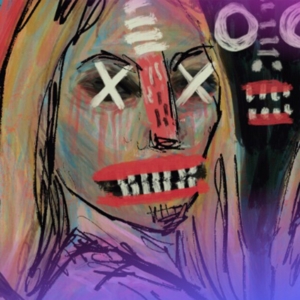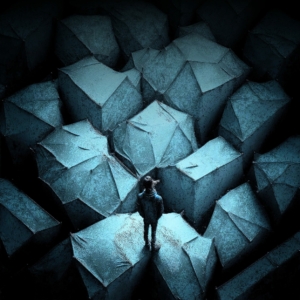Estar y no ser. Implicados en un mundo donde prima el momento y la emoción. Futuro y felicidad aparte, ¿qué consecuencias tiene para la identidad del artista en el hoy? Me hago esta pregunta inspirado por tres autores que han analizado el comportamiento de la sociedad actual; y trasladando su influencia al mundo del arte:
El sociólogo Zygmunt Bauman utiliza el concepto de modernidad líquida para describir la fragilidad, la incertidumbre y la inestabilidad de las relaciones sociales, económicas y culturales de nuestro entorno, donde todo cambia a una velocidad vertiginosa y nada es sólido ni duradero; todo se vuelve líquido y se escapa de nuestras manos. ¡Cuánto daño ha hecho el «Be water, my friend»!, me sonrío mientras escribo estas líneas.
El filósofo Guy Debord denuncia la alienación de las masas por medio de la imagen, el consumo y el entretenimiento con lo que él define como sociedad del espectáculo. En ella, la realidad se sustituye por una representación falsa y manipulada que nos hace creer que somos libres y felices, pero que en realidad nos somete a los intereses del poder y el mercado.
Por otro lado, con la era del vacío, el filósofo Gilles Lipovetsky caracteriza la pérdida de sentido y de valores en la cultura occidental. La ausencia de proyectos colectivos, de ideales compartidos y de compromisos éticos ha dado lugar a la proliferación de individualismos narcisistas, de hedonismos efímeros, de nihilismos depresivos.
Estas tres perspectivas parecen indicar que vivimos en la era del estar y no del ser, en un mundo inmediato y pasajero. ¿Nos convierte esto en sujetos sin identidad definida ni propósito trascendente? ¿Qué papel ocupa entonces en la sociedad un arte que no aspira a trascender?
ARTISTA, MERCADO Y ARTE: MÉNAGE À TROIS, O PERVERSO TRIÁNGULO AMOROSO
Estar en el arte contemporáneo implica constante movimiento, perpetua fluidez y transformación. Las corrientes artísticas emergen y desaparecen rápidamente, las técnicas y los estilos se transforman en un abrir y cerrar de ojos. El arte actual se caracteriza por su fugacidad, su falta de permanencia y su adaptabilidad a las tendencias del momento. Es la ley del mercado.
A veces, en mi cabeza, represento al mercado del arte como ese tercero, entrometido en la relación idílica de arte y artista. Uno que aparece y se hace valer, a través de sus normas, como portador de pragmatismo, seguridad, estabilidad y dinamismo en una relación excesivamente emocional y desordenada. Cordura, que le llaman.
Así, en contraste, el ser artista se ve desafiado. La idea de una identidad artística sólida y definida se vuelve difusa. En el arte, más mercado que nunca, el artista se enfrenta a la presión de reinventarse y estar a la vanguardia, de captar la atención de todos. La apariencia y la espectacularidad cobran mayor relevancia que el mensaje o la reflexión profunda. La emoción se busca de manera inmediata sin dar lugar a la contemplación y la crítica; a aprehender.
Claro es que estas tendencias afectan la identidad del artista. La presión por destacar y ser relevante en un entorno saturado de estímulos visuales y mediáticos puede llevar a una pérdida de autenticidad y de integridad. La búsqueda de la aprobación y la validación externa puede, y quiero creer que solo puede, prevalecer sobre la expresión personal y la exploración genuina. Es entonces, cuando esa cordura portadora de equilibrio se torna fuente de inseguridad con capacidad de volarlo todo por los aires, el momento de sabernos aún decisores en la relación que nos permite sobrevivir.
SUPERFICIAL NO ES ANTÓNIMO DE AUTÉNTICO
La superficialidad y la autenticidad son conceptos tradicionalmente opuestos. La superficialidad implica quedarse en lo banal, sin profundizar ni indagar más allá de la apariencia o las emociones inmediatas y efímeras. Por otro lado, la autenticidad implica ser genuino, sincero y fiel a uno mismo, una exploración de la propia identidad, de las emociones y experiencias personales, requiriendo una conexión interna y una expresión sincera de lo que uno es y siente.
Sin embargo, esa sociedad que nos empuja a relacionarnos superficialmente con el exterior no nos imposibilita mantener una relación profunda y honesta con nosotros mismos. Precisamente es en esa soledad cuando, según esa misma tradición, la genialidad del artista ocurre, aparece, en un momento donde la sinceridad y la habilidad del artista se concentran en la creación de la obra. Sin olvidar que hay quienes utilizan elementos aparentemente vacíos como desafío, para cuestionar las normas establecidas y generar una reflexión más profunda en el espectador.
ARTISTA, NO HÉROE
Si bien el arte tiene el poder de generar conciencia y despertar emociones, no siento que mi responsabilidad como artista sea cambiar el mundo. Me gusta representar cómo siento aunque no siempre pretendo compartirlo. Mi objetivo personal es capturar emociones, reflexionar y, a veces, propiciar vínculos entre espectador y mis pensamientos convertidos en obra.
Podría decir que mi labor, pues, es mostrar mi ventana a la realidad, ofrecer una visión subjetiva de lo que me conmueve positiva o negativamente. Ni siquiera la denuncia es necesaria; en ocasiones tan solo pretendo señalar para que el espectador interprete, construya su relato y decida. Así, en última instancia, el impacto y las acciones que surgen a partir de ese mensaje son responsabilidad de aquellos que interactúan con mi arte.
El arte puede actuar como un catalizador para el cambio, pero su verdadero poder radica en su capacidad para inspirar, estimular el pensamiento crítico y fomentar el diálogo. Cada individuo que se vea afectado por una obra tiene la libertad de interpretarla y decidir si quiere tomar acción o no. Una tarea que recae en toda nuestra sociedad.
To be and not to be. To be caught up in a world where the moment and emotion prevail. Beyond the future and happiness, what are the consequences for the artist’s identity today? I ask myself this question, inspired by three authors who have analysed the behaviour of contemporary society and applied their influence to the world of art:
The sociologist Zygmunt Bauman uses the concept of «liquid modernity» to describe the fragility, uncertainty and instability of social, economic and cultural relations in our environment, where everything changes at breakneck speed and nothing is solid or permanent; everything becomes liquid and slips through our fingers. How much damage has been done by «Be water, my friend», I smile to myself as I write these lines.
The philosopher Guy Debord denounces the alienation of the masses through images, consumption and entertainment, which he defines as the society of the spectacle. In this society, reality is replaced by a false and manipulated representation, which makes us believe that we are free and happy, but in reality subjects us to the interests of power and the market.
On the other hand, the philosopher Gilles Lipovetsky characterises the loss of meaning and values in Western culture as the Age of Emptiness. The absence of collective projects, shared ideals and ethical commitments has led to the spread of narcissistic individualism, ephemeral hedonism and depressive nihilism.
These three perspectives seem to indicate that we live in the age of being and not of being, in an immediate and transient world. Does this make us subjects without a defined identity or transcendent purpose? What is the role of art that does not seek transcendence in society?
ARTIST, MARKET AND ART: A MÉNAGE À TROIS OR A PERVERSE LOVE TRIANGLE
To be in contemporary art is to be in constant motion, in perpetual flux and transformation. Artistic trends appear and disappear quickly, techniques and styles change in an instant. Contemporary art is characterised by its transience, its lack of permanence and its adaptability to the trends of the moment. This is the law of the market.
Sometimes, in my mind, I see the art market as the third party that interferes with the idyllic relationship between art and artist. One that appears and asserts itself through its rules as the bearer of pragmatism, security, stability and dynamism in an overly emotional and disorderly relationship. Sanity, they call it.
In contrast, being an artist is called into question. The idea of a solid and defined artistic identity becomes blurred. In art, which is more market than ever, the artist is under pressure to reinvent himself, to be at the forefront, to attract everyone’s attention. Appearance and ostentation become more important than message or deep reflection. Immediate emotion is sought, with no room for contemplation and criticism, for anxiety.
Of course, these tendencies have an impact on the identity of the artist. The pressure to stand out and be relevant in an environment saturated with visual and media stimuli can lead to a loss of authenticity and integrity. The quest for approval and external validation can, and I would like to believe only can, take precedence over personal expression and genuine exploration. When this balancing sanity becomes a source of insecurity with the capacity to blow everything up, it is time to know that we are still crucial to the relationship that allows us to survive.
SUPERFICIAL IS NOT THE OPPOSITE OF AUTHENTIC
Superficiality and authenticity are traditionally opposing concepts. Superficiality implies staying in the banal, without going deeper or beyond appearances or immediate and fleeting emotions. Authenticity, on the other hand, implies being genuine, sincere and true to oneself, an exploration of one’s own identity, emotions and personal experiences, requiring an inner connection and a sincere expression of what one is and feels.
The society that pushes us to have a superficial relationship with the outside world does not make it impossible for us to have a deep and honest relationship with ourselves. It is precisely in this solitude that, according to the same tradition, the genius of the artist emerges, appears, in a moment when the artist’s sincerity and skill are concentrated in the creation of the work. Without forgetting that there are those who use apparently empty elements as a challenge to question established norms and to provoke a deeper reflection in the spectator.
ARTIST, NOT HERO
Although art has the power to raise awareness and arouse emotions, I don’t feel that my responsibility as an artist is to change the world. I like to express what I feel, but I don’t always intend to share it. My personal goal is to capture emotions, to reflect, and sometimes to create a connection between the viewer and my thoughts transformed into artwork.
I could say that my work is to show my window to reality, to offer a subjective vision of what moves me, positively or negatively. It is not even necessary to denounce; sometimes I just want to point out, so that the viewer can interpret, construct his own story and decide. So, ultimately, the impact and actions that result from this message are the responsibility of those who interact with my art.
Art can act as a catalyst for change, but its true power lies in its ability to inspire, stimulate critical thinking and encourage dialogue. Each individual affected by a work has the freedom to interpret it and decide whether or not to take action. This is a task for society as a whole.




